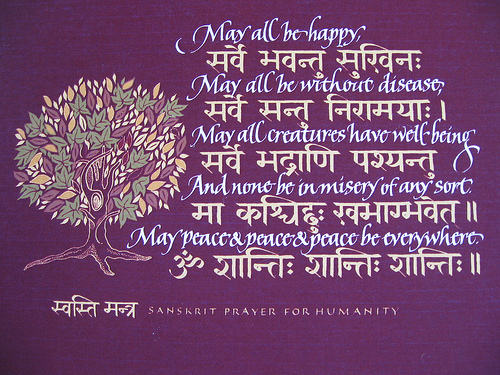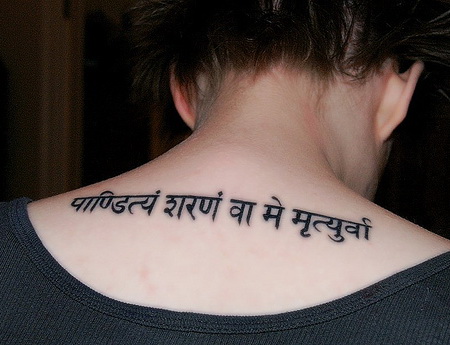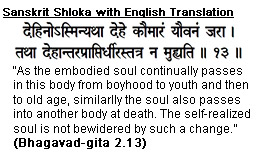
The debate on my article “Why Can’t Hindi Be National Language Of India ?” also referred to presence and importance of Sanskrit in modern times.Some readers made an infamous remark that it’s a ” dead language ”. That’s pretty ordinary claim in my eyes. Henry Shock, a scholar in Oriental studies from Illinois University visited says that ”it is highly doubtful Sanskrit is a living language, but it is never doubtful that it is living in your body.”
True,this language is our life force.This language has given birth to all major Indian languages.Even the ”standard Hindi” is comprised of words borrowed from Sanskrit.
I am posting an article that tries to analyze whether it’s a dead language or not.
Apart from the article,excerpts from other articles are also being produced.
*********************************
Why Is The West Crazy About A ‘Dead’ Language?
Ajit Kumar Jha finds some of the biggest stars in academia teach Sanskrit.
Imagine going to Varanasi to study the tragedies of the Greek playwright Sophocles. Ludicrous? It seemed equally foolish to me when on my way to California some years ago, I met the daughter of a Marxist political economist from Calcutta, who was headed for Chicago, to pursue her doctoral degree in Sanskrit. The double irony of the situation befuddled me: even the Marxists were turning over-zealous to revive Sanskrit, and strangely one had to go to the West to do so!
Yet the irony has been in place for over two centuries now. Even as we neglect our rich cultural heritage, it is the West that has revived interest in the East. Notwithstanding Edward Said’s powerful attack on the “Eurocentric” epistemology of Orientalism, and political correctness apart, half a century after Independence, it is actually the Occident that is busy rediscovering the genius of the Orient.
Ever since 1786, when Sir William Jones, in a paper presented to the Royal Asiatic Society, in Calcutta, said, ”the wonderful structure” of the Sanskrit language, is ”more perfect than the Greek, more copious than the Latin, and more exquisitely refined than either,” the West has been busy learning from Sanskrit.
This Western passion for the oriental classics is not only limited to Peter Brook’s brilliant dramatic rendering of the Sanskrit epic, Mahabharata, or to the more recent attempt by Lee Siegel to write a sensuously funny modern day Kamasutra in a fictionalised form, entitled Love in a Dead Language. There is a much more systematic tradition of Sanskrit learning of over two centuries. Not surprisingly to a question about why should one study Sanskrit today, and whether it has any future, Professor Sheldon Pollock of the University of Chicago had the following answer: ”It is indicative of the appalling quality of the public discourse on Sanskrit in India today that you even ask this question.”
While we battle each other on the streets on whether Sanskrit should be revived in the school curricula or not, top notch western universities have been busy churning one esoteric dissertation after another on Panini’s Ashtadhyay and comparing Bhartihari’s and Patanjali’s grammatical logic.

There are essentially two traditions of teaching Sanskrit in the West today: one scholastic, as a classical subject taught in the universities; the other as a religious discourse in the various temples being built by the cash rich Indian diaspora. The scholastic tradition, which began a couple of centuries ago continues till today. The temple tradition is a post-1965 phenomena, the year President Lyndon Johnson liberalised immigration quotas. Today, the children of the first wave of professional Indian immigrants to the US—mainly doctors and engineers—have entered the university in large numbers. It is these alienated kids, desperate to discover their historical roots and cultural heritage, who are studying Sanskrit with a passion.
The British tradition
The first chair in Sanskrit in England, the Boden Chair, was set up at Oxford in 1831. Later chairs were founded in University College, London, Edinburgh, and Cambridge. The Boden chair continues till today in addition to two other faculty positions. Professor Richard Gombrich, the present occupant of the chair, is known worldwide for his extraordinary work on Theravada Buddhism.
According to Gombrich: ”The reasons for studying Sanskrit today are the same as they ever were: that the vast array of Sanskrit texts preserves for us a valuable part of the cultural heritage of mankind, including much beautiful literature and many interesting, even fascinating, ideas.”
Today Oxford offers three kinds of degrees in Sanskrit: the three-year BA, the two-year M.Phil in classical Indian religion, for which Sanskrit is taught intensively, and the D Phil. The majority of the undergraduates are usually British students, while the research students are mostly from overseas, including a few Buddhist monks and nuns from South-East Asia.

In an attempt to popularise Sanskrit, Gombrich, has become associated with a new publishing venture. In the style of the Loeb classical library of Latin and Greek, the series will produce readable translations of Sanskrit literary texts printed alongside the originals.
The chair of Sanskrit in Edinburgh was established by the endowment of John Muir. The university of Edinburgh offers either a full honours course in Sanskrit or a joint honours course with Latin, Greek or Linguistics. Unfortunately, the interest in Sanskrit in Britain arose largely through colonial involvement. This, Dr John Brockington, who today teaches Sanskrit in Edinburgh feels, ”has been at once the strength and the weakness of Sanskrit studies in Britain”. The end of British rule in 1947 dampened the interest in Sanskrit, for instance, the Edinburgh chair was disestablished in 1949.
The American tradition
The Sanskrit craze has, however, caught up in the US. Unlike Britain, and unlike its own past, it is totally demand driven.
But first, some background. The teaching of Sanskrit first began at Yale university under professor Salisbury in the late 19th century. His student William Dwight Whitney became the pioneer in the development of American Sanskrit studies. This soon spread to Harvard, Berkeley, Chicago, Michigan, Pennsylvania and other campuses.
Today several American campuses offer Sanskrit along with modern Indian languages such as Hindi, Urdu, Punjabi and Tamil. Student unions sit on hunger strikes demanding more and more departments. It has happened at the University of Texas at Austin and in various California campuses.
Although Sanskrit began to be taught at the University of Michigan, as early as the 1890s as part of Oriental languages, today, it is attracting large undergraduate crowds. Until 1985, it was primarily a graduate subject attracting mainly foreign students. Not any more. Most second generation Indo-American kids majoring in engineering, medicine, and business studies read Sanskrit not as a specialised branch but to satisfy the four-term foreign language requirement.
The University of Chicago attracts almost 30 or more undergraduate students every year to study Sanskrit. There are five faculty members teaching Sanskrit. Ditto at Harvard University which has a full fledged department of Sanskrit. In the other US universities it is a part of the South Asian departments and very popular among the Indo-American kids.
However, the interest in Sanskrit persists even in those places where there is no demand. The last conference of the International Association of Sanskrit studies held at Turin, in Italy, according to Brockington was, an eye-opener. There were a number of Sanskrit scholars from the Eastern European countries, including Poland, Hungary, Croatia, Bulgaria, and Russia. Unlike the US, most of these countries hardly have much of an NRI population. They hardly have any temples. No community funding, no involvement of local populations. Yet, the zeal for Sanskrit continues.

While we in India today consider Sanskrit a dead language, the Westerners consider it as simply a fascinating language, a language in which the genius of the human civilization was perfected to its fullest.
***
While we battle each other on the streets on whether Sanskrit should be revived in the school curricula or not, top notch western universities have been busy churning one esoteric dissertation after another on Panini’s Ashtadhyay and comparing Bhartihari’s and Patanjali’s grammatical logic.
***
The wonderful structure of Sanskrit is better than Latin.
********************************
Reviving Sanskrit Teaching
By Mohan Gupta
Sir Monier-William made a lengthy and learned introduction to his monumental work: Sanskrit-English Dictionary. In his introduction he wrote, “By Sanskrit is meant the learned language of India – the language of its cultured inhabitants, the language of its religion, its literature and science – not by any means a dead language, but one still spoken and written by educated men by all parts of the country, from Kashmir to Cape Comorin, from Bombay to Calcutta and Madras”
”In a landmark judgment delivered in October 1994 the Supreme Court of Bharat held that without learning Sanskrit it was not possible to decipher Bharatiya philosophy, culture and heritage. All the classics such as Vedas, Puranas and Upanishads, and the most enlightening literature of Kalidasa, Bhavabhuti, Banbhatta, Dandi etc. were in Sanskrit. The teachings of Sankracharya, Ramanuja, Madhvacharya, Nimbarka and Vallabhacharya would not have been possible without this language, said the judges of the apex court, laying special emphasis on the historical relevance of this ancient language.”
Sardar K.M. Panikkar pointed out, “It is one common inheritance of Bharat. The unity of Bharat will collapse if it breaks away from Sanskrit and the Sanskritic traditions.” Dr. Rajendra Prasad said, “Sanskrit provided perhaps the most important focal point from which emanated cultural and political unity.” K.M. Munshi aptly pointed out that “without Sanskrit Bharat would be nothing but a bundle of linguistic groups.”
********************************
”Sanskrit is the mother of all languages, and it could become the unifying language of India, apart from English, which is spoken only, by a tiny minority. ”Sanskrit ought still to have a future as the language of the learned and it will not be a good day for India when the ancient tongues cease entirely to be written or spoken”, admonished 50 years ago Sri Aurobindo, India’s great Sage and Seer.
A dead language, you say! Impossible to revive? But that’s what they argued about Hebrew. And did not the Jewish people, when they got back their land in 1948, revive their ”dead” language, so that it is spoken today by all Jewish people and has become alive again? The same thing ought to be done with Sanskrit.
Source: http://www.pragna.org/Iss02412.html.
**************************
Juan Mascaro (1897 – 1987) taught at Oxford University, Parameshvara College at Jaffna, the University of Barcelona, and Cambridge University.
He was the author of The Bhagvad Gita – translated By Juan Mascaro. Penguin Classics, 1962) and he paid a rich tribute to the glory of the Sanskrit literature:
”Sanskrit literature is a great literature. We have the great songs of the Vedas, the splendor of the Upanishads, the glory of the Upanishads, the glory of the Bhagavad Gita, the vastness (100,000 verses) of the Mahabharata, the tenderness and the heroism found in the Ramayana, the wisdom of the fables and stories of India, the scientific philosophy of Sankhya, the psychological philosophy of yoga, the poetical philosophy of Vedanta, the Laws of Manu, the grammar of Panini and other scientific writings, the lyrical poetry, and dramas of Kalidasa. Sanskrit literature, on the whole, is a romantic literature interwoven with idealism and practical wisdom, and with a passionate longing for spiritual vision.”
(source: The Bhagvad Gita – translated By Juan Mascaro Penguin Classics, 1962).
*******************
Sri Aurobindo Ghosh (1872-1950) most original philosopher of modern India. Education in England gave him a wide introduction to the culture of ancient, or mediaeval and of modern Europe.
He wrote:
”The ancient and classical literature of the Sanskrit tongue show both in quality and in body an abundance of excellence, in their potent originality and force and beauty, in their substance and art and structure, in grandeur and justice and charm of speech, and in the heightened width of the reach of their spirit which stands very evidently in the front rank among the world’s great literature.”
(source: Foundations of Indian Culture – By Shri Aurobindo Ghosh p. 255).
Source: Hindu Wisdom
**************************




